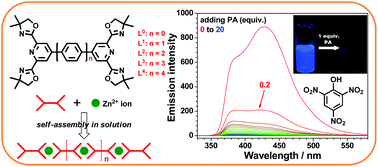Fluorescence tuning of Zn(ii)-based metallo-supramolecular coordination polymers and their application for picric acid detection†
Abstract
In this study, we report the synthesis of five one-dimensional Zn(II)-based metallo-supramolecular polymers P0–4 through 1 : 1 complexation of Zn(SO3CF3)2 or Zn(ClO4)2 with ditopic ligands L0–4 which contain two pyridine-dioxazole (pybox) units connected by a rigid conjugated oligo(1,4-phenylene) linker. The new Zn(II)-based polymers displayed relatively high quantum yields in solution and the solid state and showed tunable luminescent colors from blue to yellow owing to the conjugation effect of the ligand and the intra-ligand charge transfer (ILCT) between the coordination site and the chromophore of the ligand. Moreover, the polymer solution could exhibit white light emission by simply regulating the metal/ligand ratio or mixing different polymers. The polymers have been further explored as fluorescent chemosensors (FCs) for detecting nitroaromatic explosives. Among others, P1 possessed the highest capability for detecting picric acid (PA).



 Please wait while we load your content...
Please wait while we load your content...